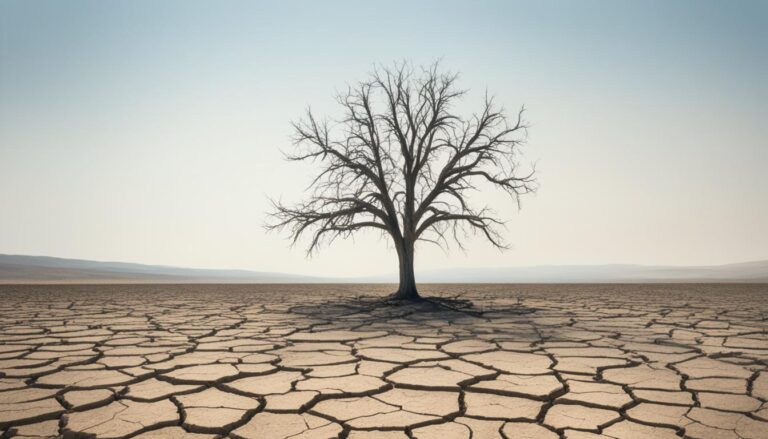Unveil Energy Movement in Ecosystems – Discover How
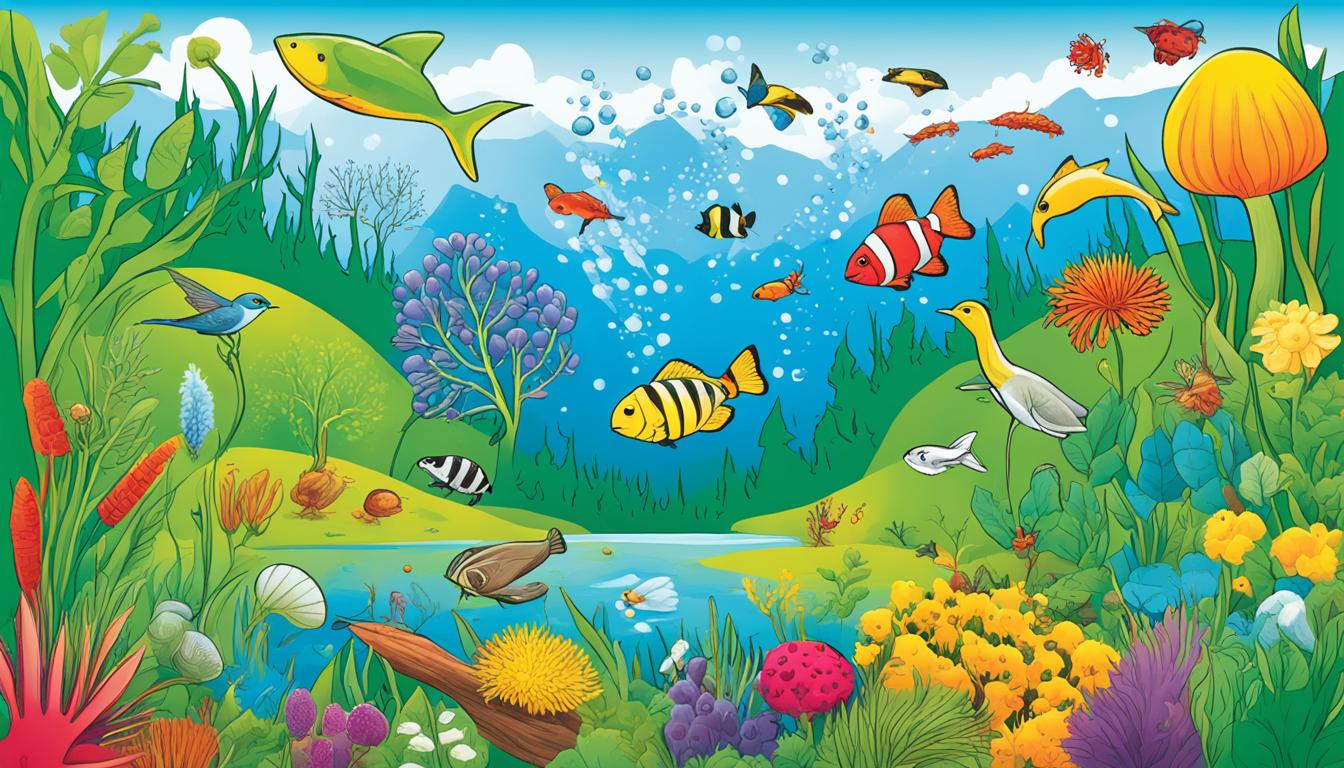
Have you ever wondered how energy moves through an ecosystem? How does energy transfer from one organism to another, shaping the dynamics of ecological systems? Understanding the intricacies of energy movement in ecosystems is key to unraveling the interconnectedness and fragility of these complex systems.
Key Takeaways:
- Energy movement in ecosystems determines their functioning and dynamics.
- Freshwater, marine, and terrestrial ecosystems differ in size, habitat, and the organisms they support.
- Food webs illustrate the flow of energy through trophic levels, from producers to decomposers.
- Living organisms acquire energy as autotrophs or heterotrophs within food webs.
- Matter cycles through ecosystems, while energy flows unidirectionally.
Understanding Ecosystem Categories and Diversity
Freshwater ecosystems, marine ecosystems, and terrestrial ecosystems are the three major categories that encompass the incredible diversity of our planet’s ecosystems. Each type of ecosystem has its unique characteristics and supports a wide range of organisms.
Freshwater Ecosystems: Covering only 1.8 percent of the Earth’s surface, freshwater ecosystems are relatively rare. These ecosystems include bodies of water such as lakes, rivers, streams, and springs. They provide essential resources and habitats for numerous species, supporting both aquatic and terrestrial life.
Marine Ecosystems: Dominating the Earth’s surface, marine ecosystems cover approximately 75 percent of our planet. They are classified into different zones: shallow ocean, deep ocean water, and deep ocean bottom. Marine ecosystems are home to diverse marine life, from microscopic organisms to large marine mammals.
Terrestrial Ecosystems: Terrestrial ecosystems comprise the vast land areas of the Earth and are categorized into biomes based on similar climatic conditions. These biomes include tropical rainforests, savannas, deserts, grasslands, temperate forests, and tundras. They support a wide array of plant and animal species, each adapted to their specific environment.
Visual Representation: Ecosystem Types
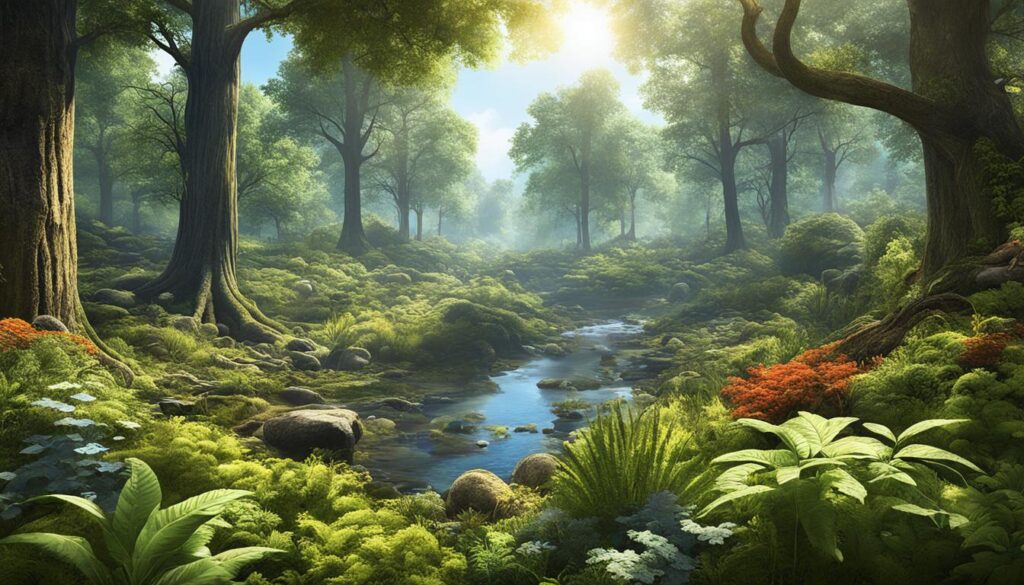
The image above illustrates the three major types of ecosystems: freshwater ecosystems, marine ecosystems, and terrestrial ecosystems. It provides a visual representation of their distribution and diversity on Earth.
Exploring Food Webs and Energy Flow
Food webs play a crucial role in understanding the energy dynamics within ecosystems. In these intricate networks, species interact with each other, forming a complex web of energy flow and trophic relationships. Let’s delve deeper into how food webs depict the transfer of energy and the organization of trophic levels.
A food web is a visual representation of the feeding relationships and energy transfer between different organisms in an ecosystem. It showcases the interconnectedness of species as they interact through predator-prey relationships and the flow of energy from one trophic level to another.
At the base of the food web, we find the producers, which are primarily photosynthetic organisms such as plants, algae, and photosynthetic bacteria. They convert sunlight and inorganic molecules into chemical energy through the process of photosynthesis.
Moving up the trophic levels, we encounter primary consumers, also known as herbivores, which feed directly on producers. These herbivores obtain their energy by consuming plants or other photosynthetic organisms.
Next, we have higher-level consumers, also referred to as carnivores or omnivores, which feed on herbivores or other carnivores. These organisms obtain their energy by consuming other living organisms.
Finally, decomposers play a crucial role in food webs by breaking down organic matter, such as dead plants and animals, and returning nutrients back to the ecosystem. They aid in the recycling of nutrients, enabling the continuous flow of energy within the system.
The Importance of Trophic Levels
Trophic levels represent the position an organism occupies within a food web based on its feeding habits and energy source. Each trophic level has a distinct role and contributes to the overall energy dynamics within the ecosystem.
Producers, at the first trophic level, convert solar energy into chemical energy, forming the foundation of the food web. They sustain themselves and provide energy for herbivores at the next trophic level.
Herbivores, at the second trophic level, consume plants for energy, channeling the captured energy from producers to sustain their own growth and reproduction. This energy transfer continues as higher-level consumers prey on lower-level organisms, ensuring a flow of energy throughout the food web.
Decomposers, occupying their own critical trophic level, break down organic matter into nutrients that can be reused by producers. By unlocking stored energy in dead organisms and waste, decomposers contribute to the cycling of nutrients within the ecosystem.
The structure of a food web determines the balance and efficiency of energy flow in an ecosystem. If one species becomes scarce or goes extinct, it can disrupt the entire food web, affecting energy availability and potentially leading to cascading effects on other organisms.
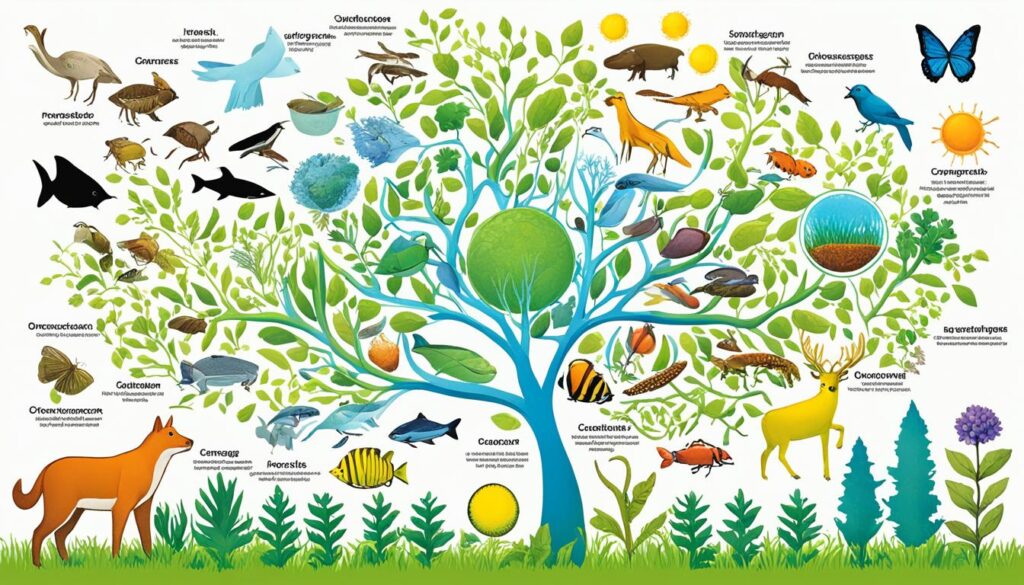
| Trophic Level | Organisms |
|---|---|
| Producers | Plants, algae, photosynthetic bacteria |
| Primary Consumers | Herbivores, such as rabbits, caterpillars |
| Secondary Consumers | Carnivores, such as snakes, hawks |
| Tertiary Consumers | Top carnivores, such as lions, eagles |
| Decomposers | Bacteria, fungi |
In the example food web above, the producers (plants, algae, and photosynthetic bacteria) capture solar energy and convert it into chemical energy through photosynthesis. The primary consumers (herbivores) then consume these producers for energy. Moving up the trophic levels, secondary consumers and tertiary consumers prey on lower trophic levels, obtaining energy from the organisms they consume.
Decomposers break down dead plants, animals, and waste material, releasing nutrients back into the ecosystem for producers to utilize. This example highlights the connectedness between different trophic levels and the importance of a balanced and diverse food web.
By understanding food webs and the flow of energy through trophic levels, we gain valuable insights into the intricate dynamics of ecosystems. These webs demonstrate the delicate balance that sustains life and emphasize the significance of maintaining biodiversity and ecological stability.
Energy Acquisition in Food Webs
Within the intricate web of life in an ecosystem, organisms acquire energy in different ways. Understanding the roles of autotrophs and heterotrophs is key to unraveling the dynamic mechanisms of energy acquisition.
Autotrophs are the primary producers in food webs, harnessing energy from sunlight or inorganic molecules through the incredible processes of photosynthesis or chemosynthesis. Plants, algae, and some bacteria are excellent examples of autotrophs. Through the magic of photosynthesis, these organisms convert solar energy into usable chemical energy, transforming it into life-sustaining nutrients. Conversely, chemosynthetic autotrophs utilize inorganic compounds to produce their energy, often found in extreme environments such as hydrothermal vents.
Heterotrophs, on the other hand, obtain their energy by consuming other living organisms or previously living matter. Common examples of heterotrophs include animals and fungi. As they devour their prey or decompose organic materials, heterotrophs release the immense potential energy stored within these resources, enabling them to thrive within their ecosystems.
The transfer of energy within food webs remains a unidirectional process. As energy flows from trophic levels such as producers, primary consumers, and secondary consumers, it gradually decreases. A considerable amount of energy is lost at each step, often in the form of heat. Consequently, decomposers play a vital role in energy acquisition, as they recycle nutrients and release energy from dead organisms and organic matter.
To visually illustrate the various trophic levels and energy acquisition in a food web, refer to the table below:
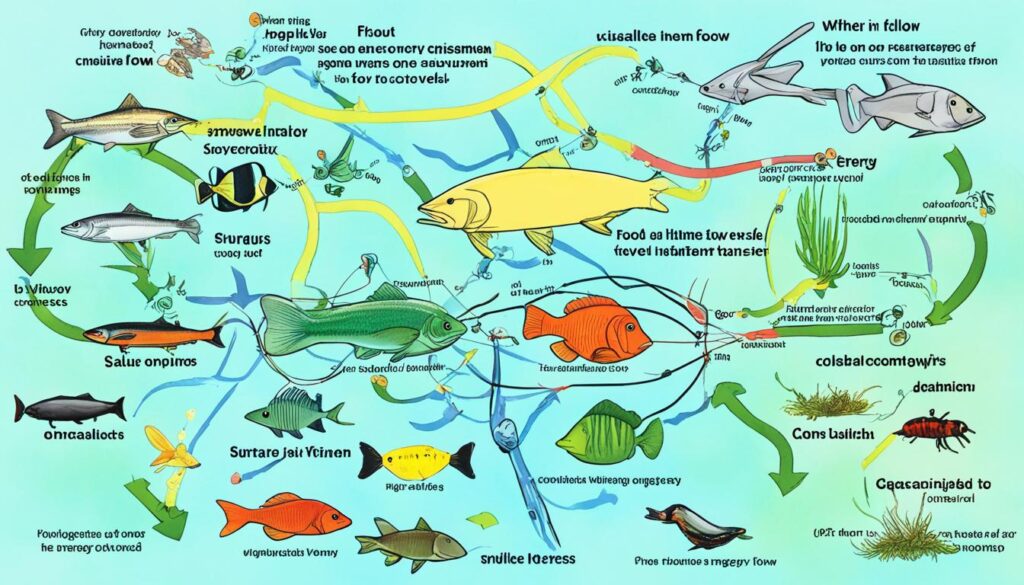
| Trophic Level | Organism Examples | Energy Source | Method of Energy Production |
|---|---|---|---|
| Producers (Autotrophs) | Plants, algae, photosynthetic bacteria | Sunlight, inorganic molecules | Photosynthesis, chemosynthesis |
| Primary Consumers (Herbivores) | Cows, squirrels, rabbits | Consuming plants | Food digestion and extraction |
| Secondary Consumers (Carnivores) | Lions, wolves, hawks | Consuming herbivores | Food digestion and extraction |
| Decomposers (Detritivores) | Fungi, bacteria, worms | Decaying organic matter | Breakdown and decomposition |
As depicted in the table, each trophic level obtains energy from the one below it, forming a delicate balance that sustains ecosystems. Furthermore, the loss of energy at each transfer emphasizes the importance of energy efficiency and highlights the role of autotrophs in capturing and converting energy from their environment.
Matter Cycling and Energy Flow
In ecosystems, matter and energy play distinct roles. Matter, in the form of elements or molecules, cycles through living and nonliving components, forming biogeochemical cycles. Common elements involved in these cycles include water, carbon, oxygen, nitrogen, phosphorus, and sulfur. Energy, on the other hand, flows unidirectionally through ecosystems, with much of it being dissipated as heat. While matter can be transferred between organisms and the environment, energy is primarily acquired through photosynthetic organisms harnessing the Sun’s energy.
Biogeochemical Cycles
The cycling of matter in ecosystems is crucial for maintaining the balance of essential elements. Biogeochemical cycles involve the transfer of these elements between the living and nonliving components of the environment. Let’s take a closer look at some of the key biogeochemical cycles:
- Water Cycle: The water cycle involves the continuous movement of water between the Earth’s surface, atmosphere, and back again. It plays a vital role in the distribution of water resources and the survival of organisms.
- Carbon Cycle: The carbon cycle is the process through which carbon is exchanged between living organisms, the atmosphere, and the Earth’s crust. It is a fundamental component of life and helps regulate Earth’s climate.
- Oxygen Cycle: The oxygen cycle is primarily driven by photosynthetic organisms, such as plants and algae, which release oxygen as a byproduct of photosynthesis. It is essential for respiration and supports the majority of Earth’s ecosystems.
- Nitrogen Cycle: The nitrogen cycle involves the conversion of atmospheric nitrogen into usable forms by nitrogen-fixing bacteria. It is necessary for the synthesis of proteins and nucleic acids and plays a vital role in the growth of plants and organisms.
- Phosphorus Cycle: The phosphorus cycle is the movement of phosphorus through the lithosphere, hydrosphere, and biosphere. It is an essential nutrient for plants and animals and is involved in various biological processes, including DNA and RNA synthesis.
- Sulfur Cycle: The sulfur cycle involves the movement of sulfur between the atmosphere, lithosphere, hydrosphere, and biosphere. It plays a crucial role in the formation of essential compounds and supports various metabolic processes.
These biogeochemical cycles ensure the availability of essential elements for living organisms and contribute to the overall balance of ecosystems.
Energy Flow in Ecosystems
Unlike matter, energy in ecosystems flows unidirectionally. The primary source of energy for most ecosystems is the Sun. Photosynthetic organisms, such as plants, algae, and some bacteria, capture solar energy through photosynthesis and convert it into chemical energy. This energy is then transferred through food chains and webs as organisms consume and are consumed by others.
Energy flow within ecosystems follows the laws of thermodynamics. The first law states that energy cannot be created or destroyed but can only be transformed from one form to another. As energy flows through ecosystems, some of it is lost as heat at each trophic level. This loss of energy influences the structure and functioning of food webs.
The second law of thermodynamics states that energy transfers are never 100% efficient. With each transfer, some energy is lost as heat, making the available energy for higher trophic levels lower than the energy at lower levels.
| Key Elements | Role in Ecosystems |
|---|---|
| Water | Provides a medium for chemical reactions, supports life, and regulates temperature. |
| Carbon | Forms the basis of organic compounds and is critical for photosynthesis and respiration. |
| Oxygen | Essential for aerobic respiration and supports the majority of Earth’s ecosystems. |
| Nitrogen | Key component of proteins and nucleic acids, necessary for plant growth and ecosystem functioning. |
| Phosphorus | Essential for DNA, RNA, and ATP synthesis, critical for energy transfer in organisms. |
| Sulfur | Involved in the synthesis of amino acids, vitamins, and coenzymes, supports metabolic processes. |
The interconnectedness of matter cycling and energy flow in ecosystems highlights the delicate balance necessary for the survival and sustainability of life on Earth. Understanding these processes is essential for preserving and protecting our planet’s biodiversity and ensuring the well-being of future generations.
Importance of Energy Input in Ecosystems
The Sun’s solar energy plays a vital role as the major source of energy in most ecosystems. Through the process of photosynthesis, photoautotrophs, such as plants, algae, and photosynthetic bacteria, capture solar energy and convert it into chemical energy. This energy is then transferred through the food webs within ecosystems, with producers incorporating it into their biomass.
The energy captured by photoautotrophs is essential for sustaining life in ecosystems. It provides the foundation for the energy flow that supports the growth and survival of all organisms within the ecosystem. As energy moves through the food webs, it is transferred to primary consumers, who rely on this energy for their own growth and survival.
The net primary productivity of an ecosystem represents the amount of energy available to these primary consumers at the next trophic level. It serves as a measure of the energy input into the ecosystem. Without an adequate energy input from photoautotrophs, the ecosystem would not have enough energy to support the higher trophic levels.
The Role of Solar Energy
Solar energy is a powerful and consistent energy source that fuels the growth of photoautotrophs. As producers harness this energy through photosynthesis, they convert it into chemical energy stored in their tissues. This energy is then passed on to herbivores, carnivores, and decomposers as they consume one another.
In addition to sustaining life within the ecosystem, solar energy also drives biogeochemical cycles in the environment. These cycles involve the movement of matter through living and non-living components of the ecosystem and are essential for maintaining the balance of nutrients necessary for life.
Overall, the input of solar energy in ecosystems is crucial for the functioning and survival of all organisms. It sustains the energy flow, drives the growth of biomass, and supports the intricate web of interactions within the ecosystem. Without this energy input, ecosystems would not be able to thrive and maintain the delicate balance of life.

Image Caption: Solar energy is the key source of energy in most ecosystems, supporting the growth and survival of organisms.
The Role of Energy Limitations in Food Webs
Energy limitations play a crucial role in shaping the dynamics and structure of food webs. As energy flows through different trophic levels, it undergoes losses at each transfer and through heat dissipation. This results in a decrease in the amount of available energy for higher trophic levels.
Imagine a food web as a pyramid, with primary producers forming the base and top predators representing the apex. The energy from the producers gradually diminishes as it moves up the trophic levels. This limitation of energy availability can have significant implications for the populations supported at higher trophic levels. If the remaining energy after losses is insufficient, these higher levels may not be sustained.
To maintain viable populations, organisms in food webs must obtain enough energy from the lower trophic levels. Those unable to secure sufficient energy may face decreased growth, limited reproductive success, and even population declines. This energy limitation acts as a natural regulatory mechanism, balancing the populations within an ecosystem.
The Consequences of Energy Limitations
The energy limitations in food webs can have far-reaching consequences. They shape the structure of the web, determining which species occupy each trophic level and their relative abundance. Additionally, energy limitations influence the interactions between different species and the stability of the entire ecosystem.
Species adaptations, such as niche partitioning and the development of specialized feeding strategies, are driven by energy limitations. These adaptations allow different species to coexist within the same ecosystem by minimizing competition for limited energy resources. By occupying different niches and targeting specific energy sources, organisms reduce direct competition for resources and maximize their energy acquisition.
This dynamic interplay between energy limitations and species adaptations contributes to the resilience and stability of food webs. It ensures that energy flows efficiently through the ecosystem, supporting the survival and persistence of diverse species.
In summary, energy limitations are a fundamental aspect of food webs. They shape the structure, dynamics, and stability of these intricate ecological networks. Understanding the interplay between energy limitations and trophic energy transfers provides insights into the functioning and conservation of ecosystems.
Conclusion
The movement of energy in ecosystems is a fundamental process that shapes the functioning and dynamics of ecological systems. By understanding the categorization and diversity of ecosystems, the complex interactions within food webs, and the acquisition of energy by different organisms, we can gain valuable insights into the flow of energy and the conservation of matter in these systems.
One crucial aspect of energy movement in ecosystems is the input of solar energy through photosynthetic organisms. These organisms, such as plants, algae, and photosynthetic bacteria, capture the Sun’s energy and convert it into chemical energy through photosynthesis. This energy is then transferred through food webs, ultimately sustaining life in ecosystems.
However, energy limitations within food webs also shape the structure and populations of organisms. As energy is transferred between trophic levels, it decreases, with some energy lost as heat. This limitation of energy flow affects the support and viability of higher trophic levels within food webs. Understanding these limitations helps us comprehend the intricate relationships and dependencies between organisms within ecosystems.
By unraveling the complexities of energy movement, we can develop a deeper appreciation for the interconnectedness and fragility of ecosystems. It highlights the importance of maintaining a balance and ensuring sustainable energy flow for the preservation of these valuable ecological systems.



